SUMMARY
The March 2003 round of the Customer Satisfaction Survey (CSS) showed that six in every ten (66%) of NSO's clients were either satisfied or very satisfied with the way NSO did its job. This was 23 percentage points higher than a year ago at 43 percent in March 2002. In December 2002 it was 62 percent.
Six in every ten (61%) of the respondents queued for only an hour during this quarter?s CSS round. This was a complete turnaround than a year ago when only 15 percent of the respondents queued for an hour in March 2002. Conversely, those who waited in line for more than 2 or 3 hours significantly decreased from a high of 68 percent in March 2002 to only 20 percent a year later.
The characteristics of NSO's clients did not vary significantly from a year ago. Majority of them were female (66%), within the 20-34 age bracket (64%), with college education (65%), working (46%), and residents of the National Capital Region (61%).
Passport and Embassy purposes remained as the dominant reasons for securing civil registry documents and specifically, they needed their passports for employment abroad. Birth and marriage certificates comprise 86 percent of the total documents requested.
How did we fare in satisfying the needs of our clients?
Sixty-six percent (66%) of the respondents for March 2003 were either satisfied or very satisfied with the way NSO did its job. This was 23 percentage points higher than a year ago at 43 percent in March 2002. In December 2002 it was 62 percent.
Those who were either dissatisfied or very dissatisfied with NSO's delivery of civil registry services significantly decreased from 32 percent in March 2002 to only 9 percent a year later. It was only 14 percent in December 2002. Those who were neither satisfied nor dissatisfied remained at 25 percent of the respondents.
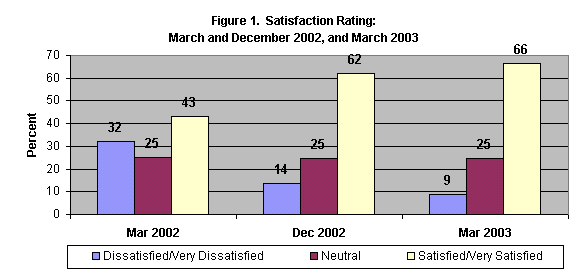
The results for the five (5) other Metro Manila Outlets, namely: Caloocan, Makati, Muntinlupa, Pasay, and Pasig Census Serbilis Centers, were analyzed separately from the main service areas at NSO East Avenue and Vibal, Edsa. Satisfaction rating was generally higher than the main service areas, except for the Pasay CenSC which had 66 percent satisfaction rating. Makati CenSC had the highest satisfaction rating at 96 percent, followed by Pasig with 89 percent, Caloocan with 80 percent, and Muntinlupa with 78 percent.
Satisfaction rating is negatively related with the average daily volume of transaction processed at these outlets. Pasay CenSC, with an average of 1,228 transactions per day, had 66 percent satisfaction ration while Makati CenSC, which only had a daily average of 236 transactions enjoyed a 96 percent satisfaction rating.
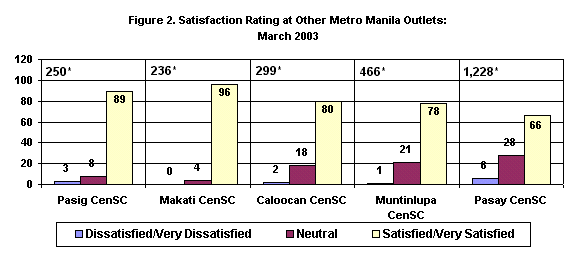
* Average daily volume of transaction per outlet in March 2003
How long did our clients wait before they were served?
Queuing Time
Six in every ten (61%) of the respondents queued for only an hour during this year's CSS round. This was complete turnaround than a year ago when only 15 percent of the respondents queued for an hour in March 2002. In December 2002, it was higher at 65 percent.
Conversely, those who waited in line for more than 2 or 3 hours significantly decreased from a high of 68 percent in March 2002 to only 23 percent a year later. It was 22 percent in December 2002. Those who waited for more than 1 hour but less than 2 hours comprised 16 percent of the respondents.
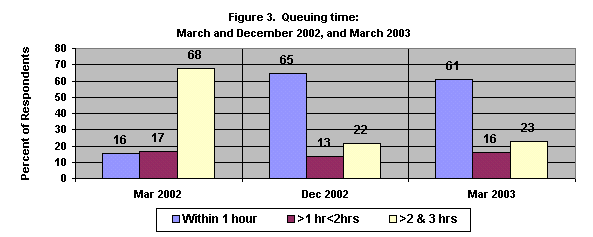
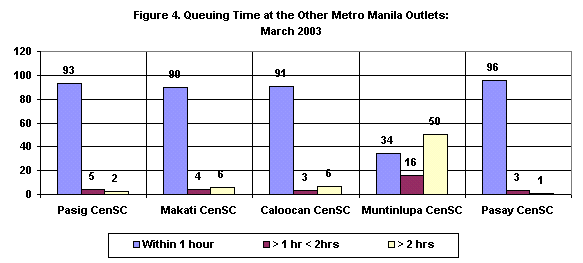
Queuing time at the five (5) other Metro Manila outlets was much shorter than at the main service areas in Quezon City. Except for Muntinlupa CenSC, which had half of its clients queuing for more than 2 to 3 hours, all other outlets had over 90 percent of their clients lining up for only an hour before being served at the counters. Pasay CenSC had the most clients lining for an hour at 96 percent.
Who are the clients/respondents?
Age
Half of the respondents are 27 years old and below. The mean age was 30 years, and the modal age was 23 years old. There were more female clients (976) than males (515). About 10 percent or 173 of the clients did not indicate their age.
Table 1. Distribution of Respondents by Age-Group by Sex
| Age Group | Female | Male | Total | |||
| Number | Percent | Number | Percent | Number | Percent | |
| <=14 | 2 | 0.2 | 4 | 0.8 | 6 | 0.5 |
| 15-19 | 99 | 10.1 | 25 | 4.9 | 124 | 8.3 |
| 20-24 | 292 | 29.9 | 127 | 24.7 | 419 | 28.0 |
| 25-29 | 200 | 20.5 | 118 | 22.9 | 318 | 21.3 |
| 30-34 | 126 | 12.9 | 96 | 18.6 | 222 | 14.9 |
| 35-39 | 93 | 9.5 | 57 | 11.1 | 150 | 10.1 |
| 40-44 | 67 | 6.9 | 32 | 6.2 | 99 | 6.6 |
| 45-49 | 45 | 4.6 | 30 | 5.8 | 75 | 5.0 |
| 50-54 | 21 | 2.2 | 10 | 1.9 | 31 | 2.1 |
| 55-59 | 20 | 2.0 | 8 | 1.6 | 28 | 1.9 |
| 60-64 | 6 | 0.6 | 5 | 1.0 | 11 | 0.7 |
| 65 and over | 5 | 0.5 | 3 | 0.6 | 8 | 0.5 |
Employment Status
Of the 1,449 respondents who replied on the question on employment status, 758 or about 52 percent said they are working while 691 or 48 percent said they are not working. Six (6) in every 10 male respondent are working while I out of 2 female respondents were not working.
Table 2. Distribution of Respondents by Employment Status by Sex
| Employment Status | Female | Male | Total | |||
| Number | Percent | Number | Percent | Number | Percent | |
| Total | 942 | 100.0 | 507 | 100.0 | 1449 | 100.0 |
| Working | 455 | 48.3 | 303 | 59.8 | 758 | 52.3 |
| Not Working | 487 | 51.7 | 204 | 40.2 | 691 | 47.7 |
Area of Residence
Sixty-two percent (62%) of those who responded (1,507) to area of residence question said they were residents the National Capital Region (NCR) while 38 percent were from areas outside NCR. Nine percent (9%) of the respondents did not indicate their area of residence.
Table 3. Distribution of Respondents by Area of Residence by Sex
| Area of Residence | Female | Male | Total | |||
| Number | Percent | Number | Percent | Number | Percent | |
| Total | 992 | 100.0 | 515 | 100.0 | 1507 | 100.0 |
| Within NCR | 623 | 62.8 | 305 | 59.2 | 928 | 61.6 |
| Outside NCR | 369 | 37.2 | 210 | 40.8 | 579 | 38.4 |
Fifty-four (54%) percent of respondents who were working were residents within the National Capital Region (NCR) while 48 percent of them came from areas outside the NCR. Of those who were not working, 46 percent were from within the NCR while 48 percent came from areas outside NCR.
Figure 5. Distribution of Respondents by Employment Status
and Area of Residence: March 2003
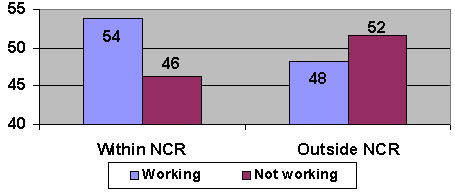
Why do they need their civil registry documents?
About 34 percent of NSO?s clients needed their civil registry documents for passport purposes (587). Of those who needed their documents for passport, 57 percent were to work abroad, 26 percent as tourist, and 17 percent to migrate.
Twenty-eight percent (28%) needed their documents as required by embassies (490), of which 64 percent were to work abroad, 20 percent as tourist, and 16 percent to migrate.
Local employment ranked third with 12 percent of the respondents indicating so.
The other purposes cited were for GSIS/SSS * 7.2 percent, school purposes 6.5 percent, marriage purposes 3.3 percent, PRC Examinations 2.3 percent, BIR/Income tax 1.3 percent, baptism requirement 0.7 percent, and 5.1 percent for other not precoded purposes.
Table 4. Purpose for Getting NSO Documents
| Purpose | Number | Percent |
| Total | 1733 | 100.0 |
| For passport | 587 | 33.9 |
| To work | 335 | 57.1 |
| As tourist | 155 | 26.4 |
| To migrate | 97 | 16.5 |
| For embassy | 490 | 28.3 |
| To work | 315 | 64.3 |
| As tourist | 97 | 19.8 |
| To migrate | 78 | 15.9 |
| For school | 112 | 6.5 |
| For local employment | 201 | 11.6 |
| For GSIS/SSS | 124 | 7.2 |
| For BIR/ITR | 22 | 1.3 |
| For baptism | 12 | 0.7 |
| For PRC exams | 40 | 2.3 |
| For marriage | 57 | 3.3 |
| For other purposes | 88 | 5.1 |
* Multiple Response
What type of these documents do they request?
Sixty-three percent (63%) of the requests for the March round of CSS were for birth certificates. Twenty-three percent (23%) were for marriage certificates. Eight percent (8%) were for authentication of documents. Authentication process involves checking of the signatories (that are loaded in the computer database) in the document brought by the clients.
Four percent (4%) were for Certificate of No Previous marriage (CENOMAR), 2 percent were for death certificate, and 1 percent for prewar certifications.
Figure 6. Percent Distribution of Type of Documents
Requested: March 2003

Background on the 1st Quarter 2003 CSS
The Customer Satisfaction Survey (CSS) for the first quarter of this year was conducted last March 24-28, 2003. Twelve (12) personnel, coming from HRMD, PMCD, and NCR-CRIMD, were assigned as interviewers. The following were the interviewers and their area of assignment:
| East Avenue and Vibal Building | Pasig CenSC | Makati Outlet |
| Virgilio Tabuzo | Connie Ko | Edna Espejo |
| Genaro Navarro | Caloocan CenSC | |
| Cosain Saripada | Gloria Velasco | |
| Myrna Genosa | Pasay CenSC | |
| Ricardo Jugao | Vilma Borreo | |
| Rodendo Alcantara | Muntinlupa CenSC | |
| Ronald Vergara | Minda Rose Vargas |
Distribution and collection of the survey questionnaires was at different times from 8:00 am to 5:00 pm for the whole week. The survey was conducted for 5 days. The daily distribution and collection of the questionnaires by service area is shown in Table 1 and 2. Of the 1,700 samples, a total of 1,664 sample respondents were interviewed representing about 12 percent of the daily average volume of applications for the 21 working days of March at 14,137.
Ms. Jocelyn Penaflor along with two (2) OJT students did the data entry in MS Excel at the Administrator's Office (AO). Generation of tables and graphs, and the analysis of the results were also done at AO.
Table 5. Daily Distribution of Questionnaires by Service Areas at Quezon City
| ServiceAreas | Monday | Tuesday | Wednesday | Thursday | Friday | Total |
| Total | 292 | 280 | 232 | 195 | 165 | 1164 |
| Application | 122 | 118 | 96 | 73 | 71 | 480 |
| Releasing | 99 | 94 | 76 | 73 | 46 | 388 |
| Endorsement | 25 | 25 | 20 | 15 | 13 | 98 |
| Party Waiting | 25 | 25 | 20 | 15 | 15 | 100 |
| Travel Agency | 21 | 18 | 20 | 19 | 20 | 98 |
Table 6. Daily Distribution of Questionnaires by Census Serbilis Outlets
| ServiceAreas | Monday | Tuesday | Wednesday | Thursday | Friday | Total |
| Total | 108 | 90 | 99 | 102 | 101 | 500 |
| Pasig | 21 | 19 | 19 | 21 | 20 | 100 |
| Makati | 20 | 20 | 19 | 21 | 20 | 100 |
| Caloocan | 23 | 16 | 20 | 20 | 21 | 100 |
| Muntinlupa | 24 | 16 | 20 | 20 | 20 | 100 |
| Pasay | 20 | 19 | 21 | 20 | 20 | 100 |
